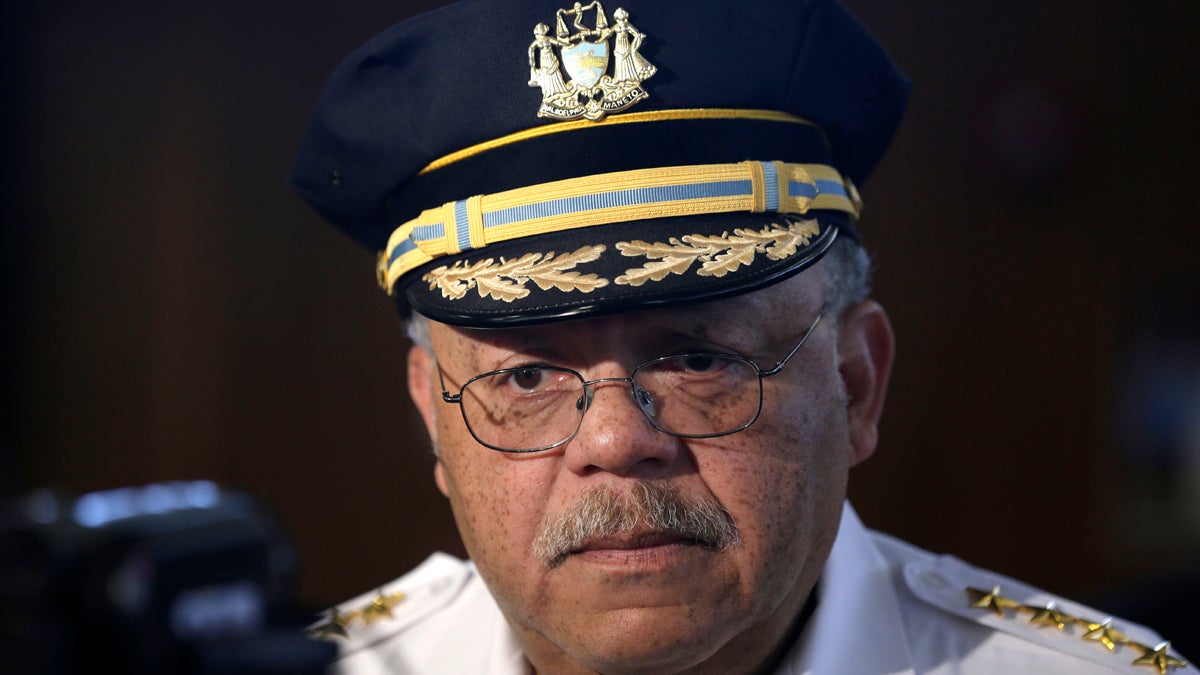Advances in crimefighting, medicine, policy help reduce Philly homicide rate
Listen
Philadelphia Police Commissioner Charles Ramsey is shown speaking to members of the media in 2013. (AP Photo/Matt Rourke)
A laminated poster inside Philadelphia Police Department headquarters lists a number of crime-fighting goals set at the beginning of 2013. Written in red marker alongside each of them, are the year-end realities.
In a year where totals dropped in nearly every major crime category, the basic chart bears largely positive news.
The reduction in homicides – 26 percent – is particularly so. The goal at the start of the year was 10 percent.
The drop translates to 247 homicides, the lowest total since 1967. There were 331 murders in 2012.
Police Commissioner Charles Ramsey said the downswing is partially a result of targeting high-crime areas known as “hot spots.”
“It’s a very basic strategy and that is, one, be very data driven – take a look at trends, take a look at patterns,” said Ramsey.
“We identified nine districts initially, problematic districts, that later became 12, where some 64 percent of our violent crime was taking place. Looking at the deployment of personnel that we have in those districts,” he said. “Our use of foot patrol.”
New York and Chicago also ended the year with figures not seen since the 1960s, but Philadelphia had the sharpest decline.
Constellation of factors
Philadelphia District Attorney Seth Williams said winning more felony convictions, especially for violent crime, contributed to that distinction too.
Four years ago, about 59 percent of felony cases were being dismissed at the preliminary hearing, often because victims or police officers weren’t showing up, said Williams. Now, about 75 percent of felony cases are being held for court.
“The more we have people being held accountable, we have fewer people sort of running around out there not being held accountable,” said Williams.
Other factors also may have contributed to the historic low. Matthew Smith, president of the Pennsylvania chapter of the National Action Network, points to all the grassroots work aimed at reducing gun violence.
It might be paying off. “People realize that if it’s you today, it can be me tomorrow. So it’s that sort of need to help, you know, that self-survival thing,” he said.
Smith also thinks the city’s trauma centers can claim some of the credit because more gunshot victims are surviving.
Early stats compiled by The Pennsylvania Trauma Systems Foundation show that fewer patients may have died in 2013 compared with 2012.
Midway through the year, the most recent statistics available, only 20 percent of victims had died of their injuries. In 2012, that total was 28 percent.
Patrick Kim, trauma director at the Hospital of the University of Pennsylvania, said research and methodology have certainly contributed to better outcomes, but that “scoop and run” – the police policy of transporting victims right away instead of waiting for ambulances – helps survival numbers too.
“For us, I do think the most important thing for a shooting victim is to be at the trauma center where most of the diagnosis and treatment is done,” said Kim. ” It’s not at all to discount any of the skills that pre-hospital providers can provide in the field, it’s just that there are many different kinds of patients and I think that really what many of us feel is that the sooner the patient can be brought to the hospital, the better the patient may do.”
Mission is not accomplished
Whatever the formula for success, Malik Aziz and other community activists say the streets still aren’t safe.
“I guess it’s all part of a strategy to at least make people feel safe because a lot of people stay in the house and watch TV,” Aziz said. “So if you can come on television and say, we have a dramatic drop in crime in the city of Philadelphia, then a lot of people are going to see that, but that doesn’t necessarily mean they’re going to believe it to come out of the door. They have to come out of the door and see that it’s safer.”
Aziz said we’re not there yet.
Ramsey agreed, saying a lot of work remains to be done. He’d like to see the murder rate dip below 200 a year.
“This isn’t standing on the ship with a mission accomplished banner behind me,” he said. ” We’re making some progress, but there’s a lot more progress to be made.”
WHYY is your source for fact-based, in-depth journalism and information. As a nonprofit organization, we rely on financial support from readers like you. Please give today.

